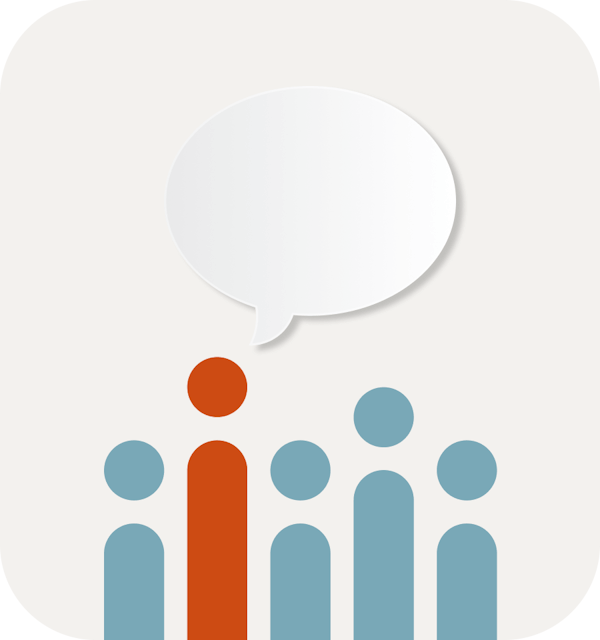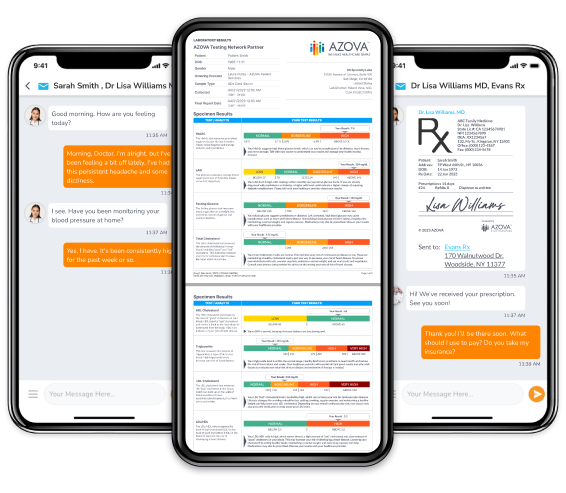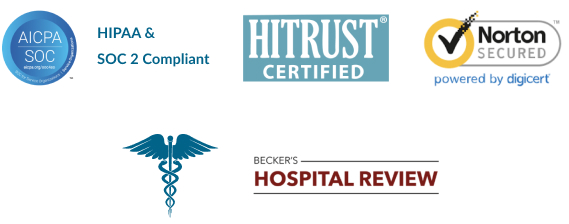Reliable headache or migraine treatment, just a click away.
Connect with a board-certified healthcare provider for headache or migraine relief via a quick, secured video visit or messaging. Receive a diagnosis and treatment plan, all without leaving home.
Available in all 50 states.

Understanding headaches and migraines
Headaches and migraines are common conditions that can significantly impact your daily life. While often grouped together, they are distinct disorders with varying symptoms and causes.
Headaches are generally characterized by a dull, steady pain in the head. They can be caused by stress, lack of sleep, dehydration, or underlying medical conditions.
Migraines are more complex and often involve throbbing pain, nausea, vomiting, and sensitivity to light and sound. They are believed to be caused by changes in brain activity and blood flow.
Types of migraines
Migraines can be categorized into several types based on their symptoms and characteristics. Here are some common types:1-3
- Migraine with aura (classic migraine): This type is characterized by neurological symptoms, known as an aura, that typically precede the headache. Auras can include visual disturbances (like flashing lights or blind spots), numbness, or tingling.
- Migraine without aura (common migraine): This is the most prevalent type, featuring headache pain without an aura.
- Menstrual migraine: This type of migraine occurs in conjunction with a woman’s menstrual cycle.
- Silent migraine (acephalgic migraine): This involves aura symptoms without a subsequent headache.
- Vestibular migraine: A type of migraine characterized by balance problems, vertigo, nausea, and vomiting, with or without a headache.
- Abdominal migraine: This migraine type primarily affects children with stomach pain, nausea, and vomiting, which often precede typical migraine headaches.
- Hemiplegic migraine: This rare type of migraine is characterized by temporary paralysis or weakness on one side of the body.
- Ocular migraine (ophthalmic or retinal migraine): This type of migraine causes brief vision loss in one eye with accompanying eye pain.
- Migraine with brainstem aura: This migraine type is characterized by dizziness, confusion, balance loss, and other neurological symptoms that often precede the headache.
- Status migrainosus: This severe migraine lasts over 72 hours with intense pain and nausea.
- Ophthalmoplegic migraine: A type of migraine with ocular symptoms, including pain around the eye, droopy eyelid, double vision, and potential paralysis of eye muscles.
- Headache or migraine symptoms in adults
- Headache or migraine symptoms in children
- Headache or migraine causes in adults
- Headache or migraine causes in children
- Headache or migraine treatments for adults
- Headache or migraine treatments for children
Headache or migraine symptoms in adults
Headaches and migraines can manifest in various ways. Common symptoms for adults include:1, 3
- Pulsating or throbbing pain: A rhythmic, intense ache in the head.
- Pain on one or both sides of the head: Discomfort concentrated on one or both sides of the head.
- Sensitivity to light (photophobia): Discomfort or pain when exposed to light.
- Sensitivity to sound (phonophobia): Discomfort or pain when exposed to noise.
- Nausea and vomiting: Feeling sick to your stomach and throwing up.
- Blurred vision: Difficulty seeing clearly or having hazy vision.
- Fatigue: Extreme tiredness or lack of energy.
- Neck stiffness: Pain and limited movement in the neck.
Headache or migraine symptoms in children
Children can experience headaches and migraines too. While symptoms are similar to adults, they may be more difficult to pinpoint. Common signs in children include:1
- Recurrent headaches: Frequent episodes of head pain.
- Vomiting or nausea: Feeling sick to your stomach and potentially throwing up.
- Sensitivity to light and sound: Discomfort or pain when exposed to light or noise.
- Changes in behavior or mood: Shifts in personality or emotional state.
- Difficulty concentrating: Trouble focusing or paying attention.
- Abdominal pain: Stomach ache or discomfort.
Headache or migraine causes in adults
While the exact causes of headaches and migraines are not fully understood, several factors can trigger them.
Common triggers for headaches and migraines1, 3
- Hormonal fluctuations: Changes in estrogen levels associated with menstruation, pregnancy, or menopause.
- Stress: Work-related pressure, relationship issues, or financial concerns
- Environmental sensitivities: Exposure to bright lights, loud noises, or strong odors.
- Sleep disturbances: Chronic sleep deprivation or inconsistent sleep patterns.
- Diet: Skipping meals, consuming excessive amounts of certain foods (e.g., aged cheeses, processed meats), or consuming specific food additives (e.g., aspartame, MSG).
- Medications: Side effects of certain prescription drugs or over-the-counter medications.
- Physical exertion: Intense physical activity or overexertion.
- Weather sensitivity: Changes in barometric pressure or temperature.
- Alcohol consumption: Excessive intake, particularly red wine.
- Caffeine intake: Excessive consumption or withdrawal.
- Sensory stimuli: Exposure to bright lights, loud noises, or strong odors.
- Genetics: Family history of headaches or migraines.
Headache or migraine causes in children1
- Brain function: Abnormal brain activity, chemical imbalances, or unique neurological patterns associated with childhood.
- School-related stress: Academic pressure, bullying, or social challenges.
- Eye strain: Increased screen time, difficulty focusing, or uncorrected vision problems.
- Sleep disturbances: Irregular sleep patterns, insufficient sleep, or excessive daytime napping.
- Dietary sensitivities: Specific food intolerances or allergies beyond common adult triggers.
- Sensory processing issues: Overwhelming responses to lights, sounds, or textures.
- Growth spurts: Hormonal changes associated with rapid growth.
- Concussion or head injury: Past head trauma with lingering effects.
- Certain medications: Side effects of drugs prescribed for childhood conditions.
These are common triggers, but individual experiences may vary. If you experience frequent or severe headaches, it’s essential to consult a healthcare professional for a proper diagnosis and treatment plan.
Headache or migraine treatments for adults
Finding relief from headaches or migraines is possible. Treatment options vary depending on the age, severity, frequency, and type of headache or migraine.
Acute treatment focuses on stopping an ongoing headache. This often includes:1-3
- Over-the-counter pain relievers: Medications like ibuprofen or acetaminophen can provide temporary relief for mild to moderate headaches.
- Prescription medications: Triptans, ergotamines, and other specialized drugs can effectively treat severe migraines.
- Combination therapies: Some medications combine multiple ingredients to address different migraine symptoms.
Preventive treatment focuses on reducing the frequency and severity of headaches. Options include:1-3
- Medications: Certain blood pressure medications, antidepressants, or anti-seizure drugs can help prevent headaches.
- Lifestyle modifications: Managing stress, getting enough sleep, and maintaining a healthy diet can significantly impact headache frequency.
- Biofeedback and relaxation techniques: These methods can help manage stress and reduce headache occurrence.
When to seek medical attention
In-person care
If you experience frequent or severe headaches that significantly disrupt your daily life, or if you notice any new or concerning symptoms, it’s important to seek immediate medical attention. Early diagnosis and treatment can help manage headaches effectively and prevent complications.
AZOVA Virtual Urgent Care
Virtual Urgent Care can be a convenient option for addressing concerns about your headaches and treatment plan, especially if you have mild or recurring symptoms.
Headache or migraine treatments for children
Acute treatment focuses on immediate relief:3
- Over-the-counter pain relievers: Medications like ibuprofen or acetaminophen can provide temporary relief for mild headaches.
- Prescription medications: For more severe migraines, a pediatrician may prescribe appropriate medications.
- Rest and hydration: Encouraging rest in a quiet, dark room and ensuring adequate fluid intake can help alleviate symptoms.
Preventive care aims to reduce headache frequency and severity:4
- Lifestyle factors: Prioritize regular sleep, a balanced diet, and physical activity.
- Trigger identification: Keeping a headache diary can help identify patterns and avoid triggers.
- Medical management: In some cases, preventive medications or supplements may be recommended under a pediatrician’s guidance.
When to seek medical attention
In-person care
If your child experiences frequent or severe headaches that significantly disrupt their daily life, or if you notice any new or concerning symptoms, it’s important to seek immediate medical attention. Early diagnosis and treatment can help manage headaches effectively and prevent complications.
AZOVA Virtual Urgent Care
Virtual Urgent Care can be a convenient option for addressing concerns about your child’s headaches and treatment plan, especially if they have mild or recurring symptoms.
Don’t suffer through headaches or migraines. Get treatment today.
References
1 National Institute of Neurological Disorders and Stroke. (n.d.). Migraine. Retrieved from https://www.ninds.nih.gov/health-information/disorders/migraine
2WebMD. (2024, March 14). Migraine: Symptoms, Causes, and Treatment. Retrieved from https://www.webmd.com/migraines-headaches/migraines-headaches-migraines
3National Institutes of Health (.n.d.). Migraine. Retrieved from https://www.ninds.nih.gov/health-information/disorders/migraine
Need help or have questions?
Contact our AZOVA Customer Support team below
Live 24/7 chat
(quickest response)
You can chat with AZOVA’s Customer Support team for comprehensive support, including help with your account, testing, shipping, and results.
We typically respond within 5 minutes. Click the messaging icon on the lower right corner of the page to get started.



